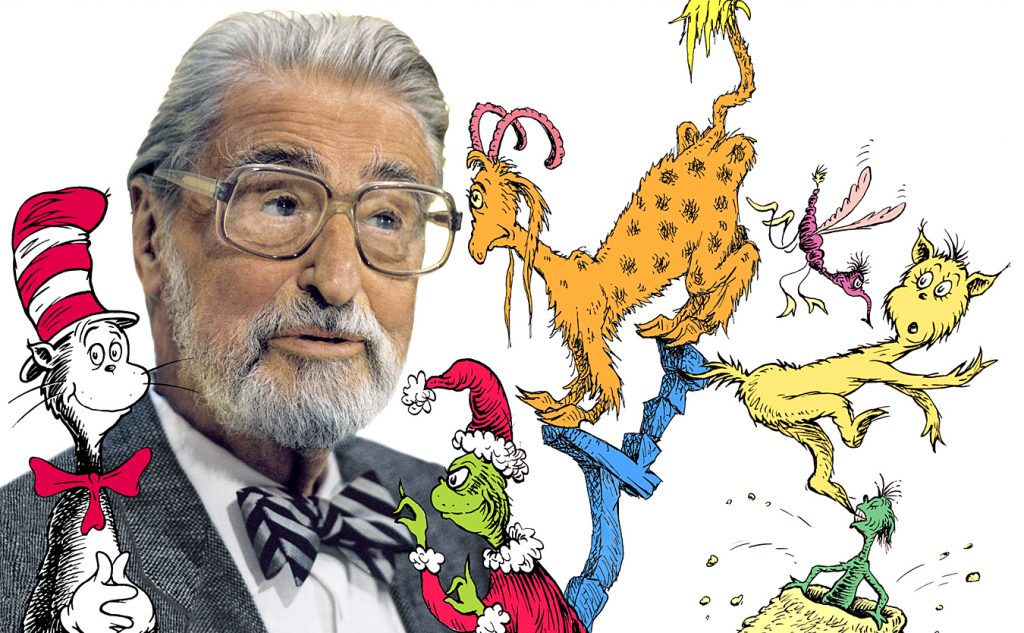Theodor Geisel, beloved children’s author, had a life before he put the hat on the cat. Born March 2, 1904, in Springfield, Massachusetts, Geisel was the only son of German-born immigrants. He spent a normal childhood with his sister and parents, before going to college to become a teacher. Geisel dropped out of college shortly before completing his doctorate in literature. He would eventually turn his almost doctorate and his mother’s maiden name into his now famous pen name, Dr. Seuss.1

In 1927, Geisel decided to turn his passion for drawing and writing into a career in advertising. One of his early successes in advertising was his drawing for Flit insecticide, whose mascot looked very similar to the cat that would eventually wear a striped hat.2 He later created an entire campaign for Essomarine Oil, a division of Standard Oil, called Seuss Navy, in which he designed certificates of membership, pamphlets, and even ashtrays and cocktail glasses that were passed out at trade shows. The Seuss Navy ads ran from 1936 to 1941, and contained many of the sea creatures that would later appear in his books.3 Geisel used many of his made up creatures in various ad campaigns and was the first person to use humor to sell products, altering the advertising industry.4

In 1941, Geisel left advertising to work as a political cartoonist for liberal New York newspaper PM. He drew over 4oo cartoons targeting such topics as isolationism, antisemitism, and racism. He routinely mocked Hitler and Mussolini, but he had a particular flair for attacking American nationalism as well. Believing that the American Nationalist Movement was just another form of fascism, Geisel made Charles Lindbergh a frequent subject of his cartoons.5 After the Japanese attack on Pearl Harbor, Geisel began to use his cartoons to support the war against Japan. He drew cartoons that “depicted Hideki Tojo, the Prime Minister and Supreme Military Leader of Japan, as an ugly stereotype, with squinting eyes and a sneering grin.”6 Geisel was in support of Japanese internment camps and drew several cartoons about them.

It can be hard to imagine that Dr. Seuss could be a racist in his depiction of Asians, but he later admitted that this was exactly the case. At the time, PM did not receive one letter of complaint about Geisel’s stereotypical depiction of Asians, although they received many letters when Geisel mocked the German dachshund, which was popular among American dog owners. Dr. Seuss later said that his 1954 book, “Horton Hears a Who,” written after a trip to Japan and dedicated to a Japanese friend, is meant to be an apology to the Japanese people for his depictions of them during World War II. In the 1980’s, Geisel looked through all his children’s books and removed anything he felt was racist, changing them for any future publication.7
Geisel’s political cartoons ended when he joined the Army in 1943. The now Captain Geisel was assigned to a unit that made training films for the Army, working with the likes of Stan Lee (creator of super heroes) and Chuck Jones (creator of the Road Runner and Wile E. Coyote).8 Geisel and Jones would become life long friends and would work together on various projects, including the animated “How the Grinch Stole Christmas,” which is still shown every year on television.

Geisel’s first children’s book was “And to Think I Saw It on Mulberry Street,” and was published in 1937. However, his writing career almost never happened. The book had been turned down by 27 publishers and Geisel was ready to give up the idea of becoming a children’s author when he ran into an old college friend while walking down the street. His friend had recently become an editor at Vanguard Press and asked Geisel to send him the book so he could show his boss. Geisel would later say in interviews that it was pure luck that he walked down that side of the street that day.9
Dr. Seuss later claimed that he did not like to write books that had a moral or ethical lesson, because children could see a lesson coming and would not want to read the book.10 However, all of Geisel’s books, except his Beginner Books, contained lessons of some sort. Dr. Seuss wrote books with lessons on environmentalism, racial equality, the pointlessness of the arms race, materialism, and respect, just to name a few. He was one of the first children’s authors to write books for children with the respect and care typically reserved for adult literature.11
Dr. Seuss died on September 24, 1991 at his home. He was asked shortly before he passed away to leave a message for children. He wrote “The best slogan I can think of to leave the kids of the U.S.A. would be ‘We can…and we’ve got to…do better than this.’ He then crossed out ‘the kids of.'”12 Dr. Seuss left a legacy of children’s literature that will not soon be forgotten, but he did more than that; Dr. Seuss taught children to think.
- Janet Schulman and Cathy Goldsmith, Your Favorite Seuss (New York: Random House, 2004), 6. ↵
- Louis Menand, “Cat People,” The New Yorker (December 2002). ↵
- Janet Schulman and Cathy Goldsmith, Your Favorite Seuss (New York: Random House, 2004), 55. ↵
- Janet Schulman and Cathy Goldsmith, Your Favorite Seuss (New York: Random House, 2004), 117. ↵
- Sophie Gilbert, “The Complicated Relevance of Dr. Seuss’s Political Cartoons,” The Atlantic (January 2017). ↵
- Sophie Gilbert, “The Complicated Relevance of Dr. Seuss’s Political Cartoons,” The Atlantic (January 2017). ↵
- Sophie Gilbert, “The Complicated Relevance of Dr. Seuss’s Political Cartoons,” The Atlantic (January 2017). ↵
- Janet Schulman and Cathy Goldsmith, Your Favorite Seuss (New York: Random House, 2004), 9. ↵
- Louis Menand, “Cat People,” The New Yorker (December 2002). ↵
- Janet Schulman and Cathy Goldsmith, Your Favorite Seuss (New York: Random House, 2004), 190. ↵
- Janet Schulman and Cathy Goldsmith, Your Favorite Seuss (New York: Random House, 2004), 84. ↵
- Janet Schulman and Cathy Goldsmith, Your Favorite Seuss (New York: Random House, 2004), 190. ↵



125 comments
Gabriela Serrato
I am so surprised by this article and the amazing insight and facts that I did not know about one of my favorite childhood authors. Would I ever imagine that Dr. Seuss had a background in political cartoons? Never. I honestly knew nothing of the background of Dr. Seuss, but I grew up with the impression that he was a man that only wrote great children books and that is all. But that is not the case, he was so much more. It is nice to know that he stuck to his beliefs and was not afraid to illustrate what he was feeling. I am also glad that he realized the racism in the one illustration and apologized for it. I thoroughly enjoyed this article.
Veronica Spryszynski
Article grabbed my attention and now I know things I haven’t known about Dr. Suess before. Ive read his books when I was younger and I enjoyed them a lot I never noticed what topics he was really teaching me about until now. I like how Geisel can transform important and adult content from his life situations to children format while still sending the same message. I think his drawing were fantastic and I learned that he started in the newspaper company with cartoons.
Michael Mandujano
During my childhood, I had always enjoyed listening or reading along the famous books by Dr. Seuss. In fact, many of my favorite titles were mentioned in this article, such as, “The Cat in the Hat,” “Horton Hears a Who,” and many other great titles. I enjoyed reflecting on my personal favorite childhood books. However, it is prestigious how Theodor Geisel voiced his opinions through cartooned illustrations. I personally do not view Geisel’s political illustrations as racist, I view them as a powerful message that was intended to raise awareness. This article was very informative and interesting, because I was also unaware of Geisel being in the Army.
Ernie Sano
Fame and success often shrouds those who are fortunate enough to attain it in in a cloak of inhumanity and perfection. The idea that the works of art that entertain us in childhood and influence us within adulthood are created by an individual that has flaws and interests just like everyone is not something that we like to ponder. This article, with its informative research, centralizes on the idea that Theodor Geisel is the embodiment of the fantasies that adolescence eventually stripped away from us. We can make a reasonable conclusion that the reasoning behind the article and its choice of subject matter is to humanize a figure that seemed, within the realm of childlike imagination, godlike.
Mariet Loredo
Dr. Suess, is easily one of my favorite authors. I grew up reading his books at school and at home. I never really went and did the research to learn about how Dr. Suess began his writing career. I found it very interesting that his drawings were used in such serious events that were happening in the world. I would of never imagined them being used in that way. I was only ever exposed with the drawing being used in fun children book. This article as very fun to read and gave me information that I did not know before. Great article!
Eric Victoria
Dr. Suess will always be known as one, if not, the greatest children’s books author ever. This article had some interesting things to tell about him that you wouldn’t expect. The fact that he admitted to be a racist really makes me think what his books would have been like if he never would have removed all of his racist material. Though it`s a good thing that he apologized for his actions and erased the error of his ways. In the end I thing thought this article to be a good story to read about a story teller.
Mark Martinez
Amazingly written and perfectly put together. In high school, I did a presentation on Theodor Geisel but it was no where near this interesting or informative. I had no idea that Dr. Seuss had joined the army, worked with the famous Stan Lee and Chuck Jones. To think it was pure luck the Dr. Seuss built up his career after meeting an old friend from college with just the right connections.
Troy Leonard
reading this article was very interesting because I’ve always been a dr. Seuss fan and I’ve read most of his books as a child. I’ve never known what his real name was or even knew what he looked like its very interesting to know that he’s done lots of other things. by the way I would have never guessed he was racist and I don’t think a lot of other people would think so to, every on is so blind to it because he is such a great author.
Clarissa Bustamante
As one of my favorite authors growing up as a kid, I never thought of the fact that Suess may not been his last name. I believe that with the incorporation Dr. Suess had with racism and isolationism it drove him down a path where he now has many creative writing pieces. it is odd how he managed to try not to write books with life lessons when most of his books do have life lessons within them.
Christine Sackey
Dr.Seuss was an incredible writer and truly a wonderful person. I liked the fact that he was not afraid to fix his mistakes and change to be a better person just like he told children to do. His life depicts a man who was not afraid to go after what he wanted and to speak the truth. I really liked that about him. I did not know much about how he started to create the characters in his book but the article explained it very well.